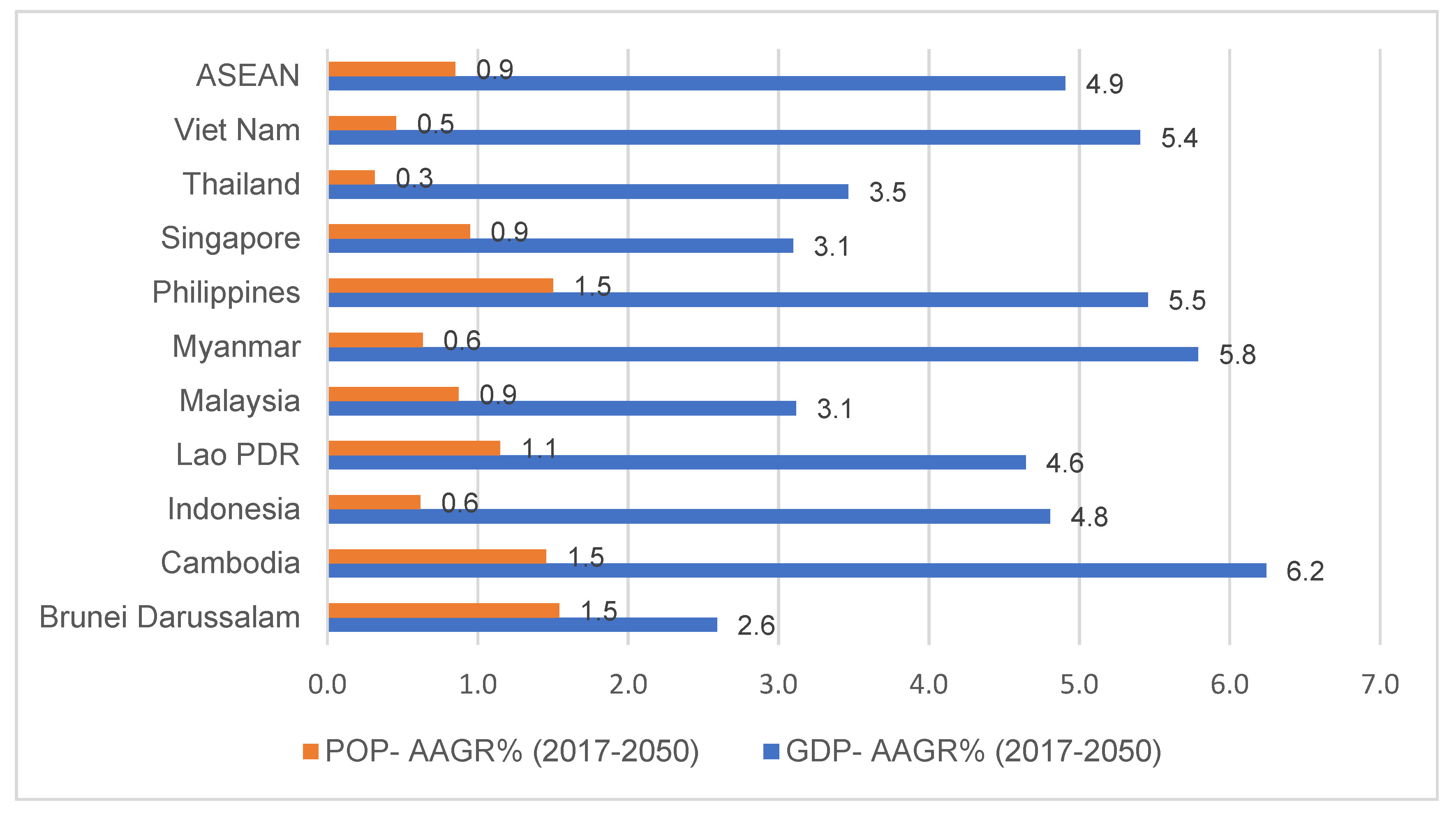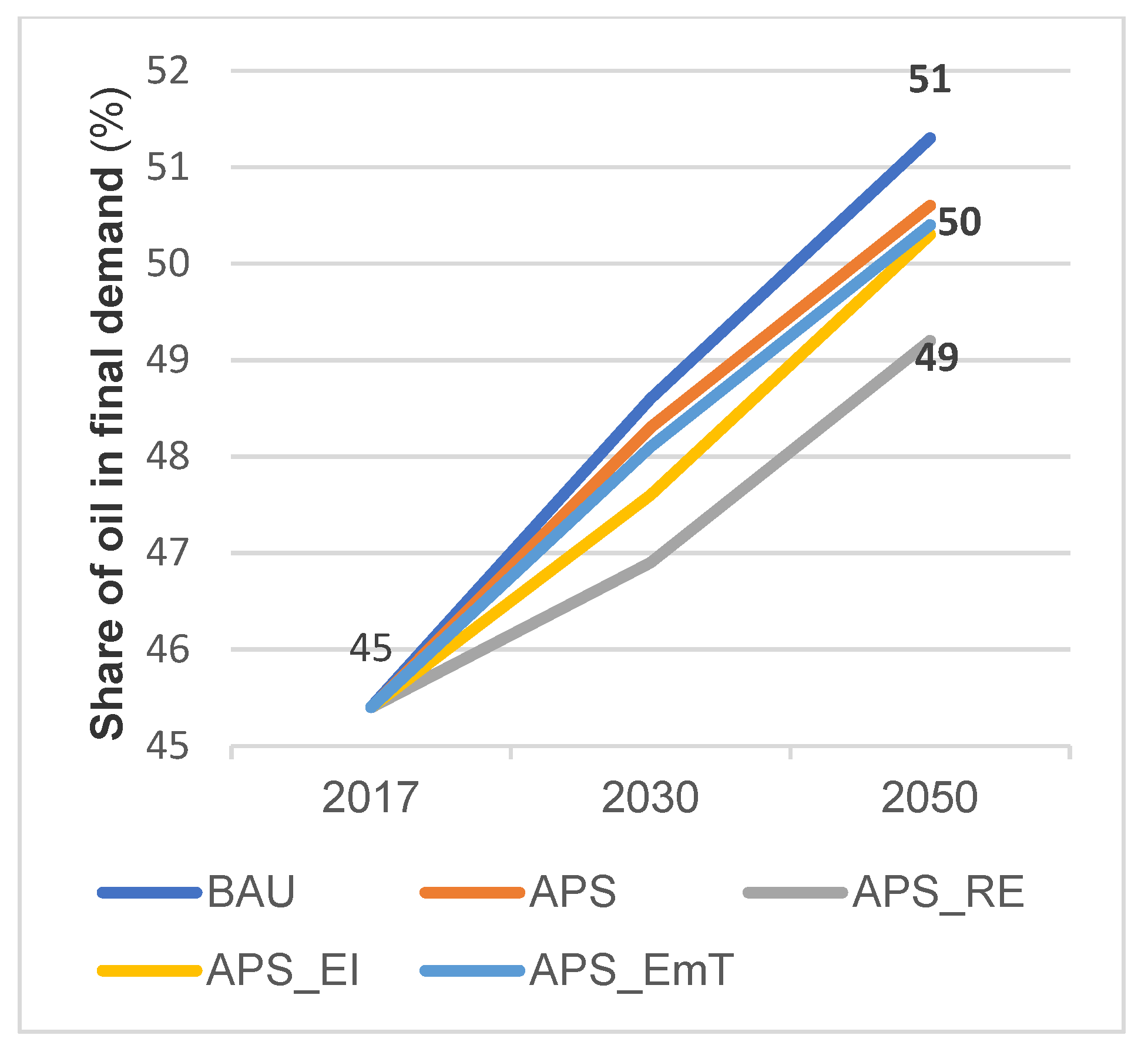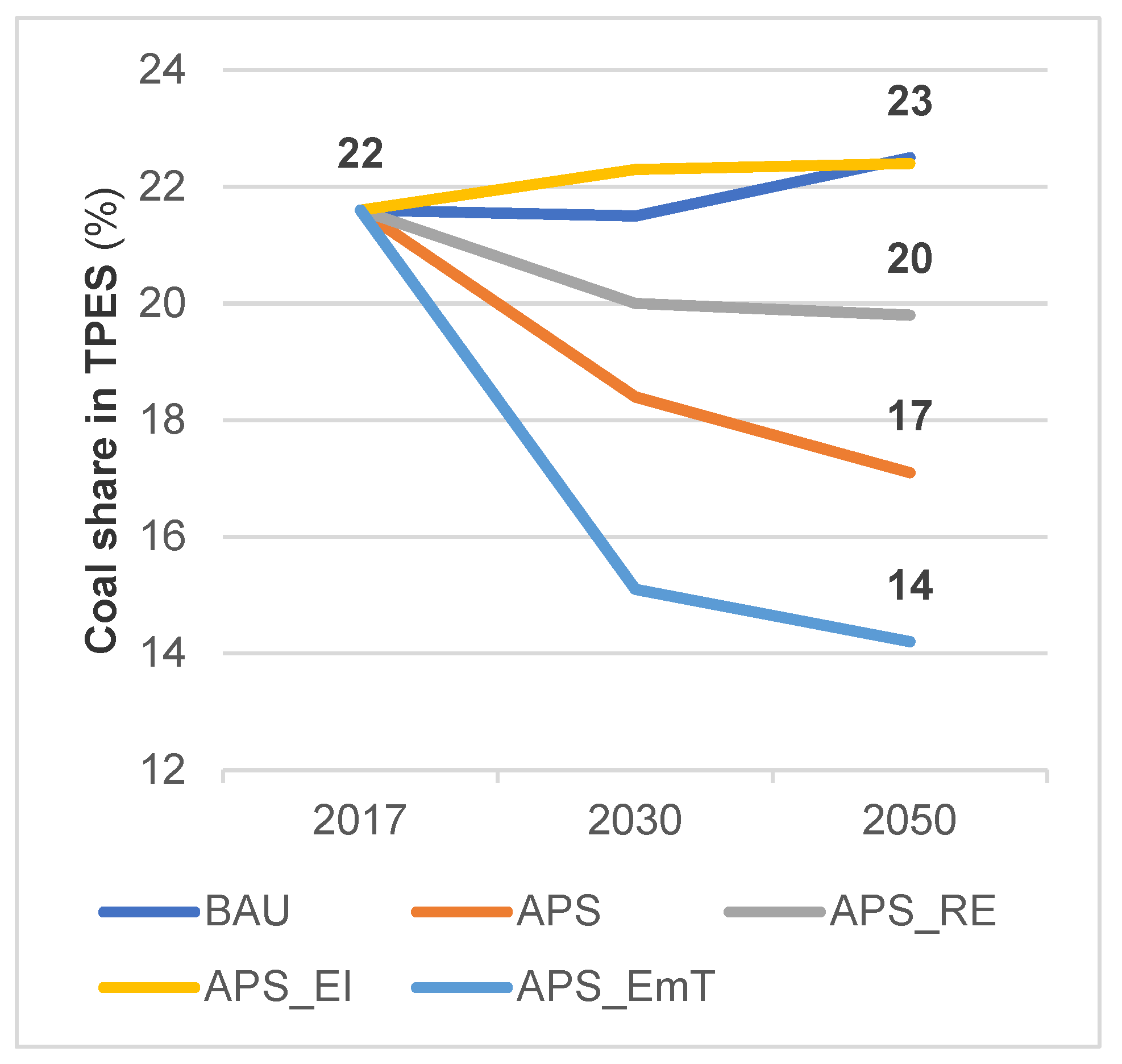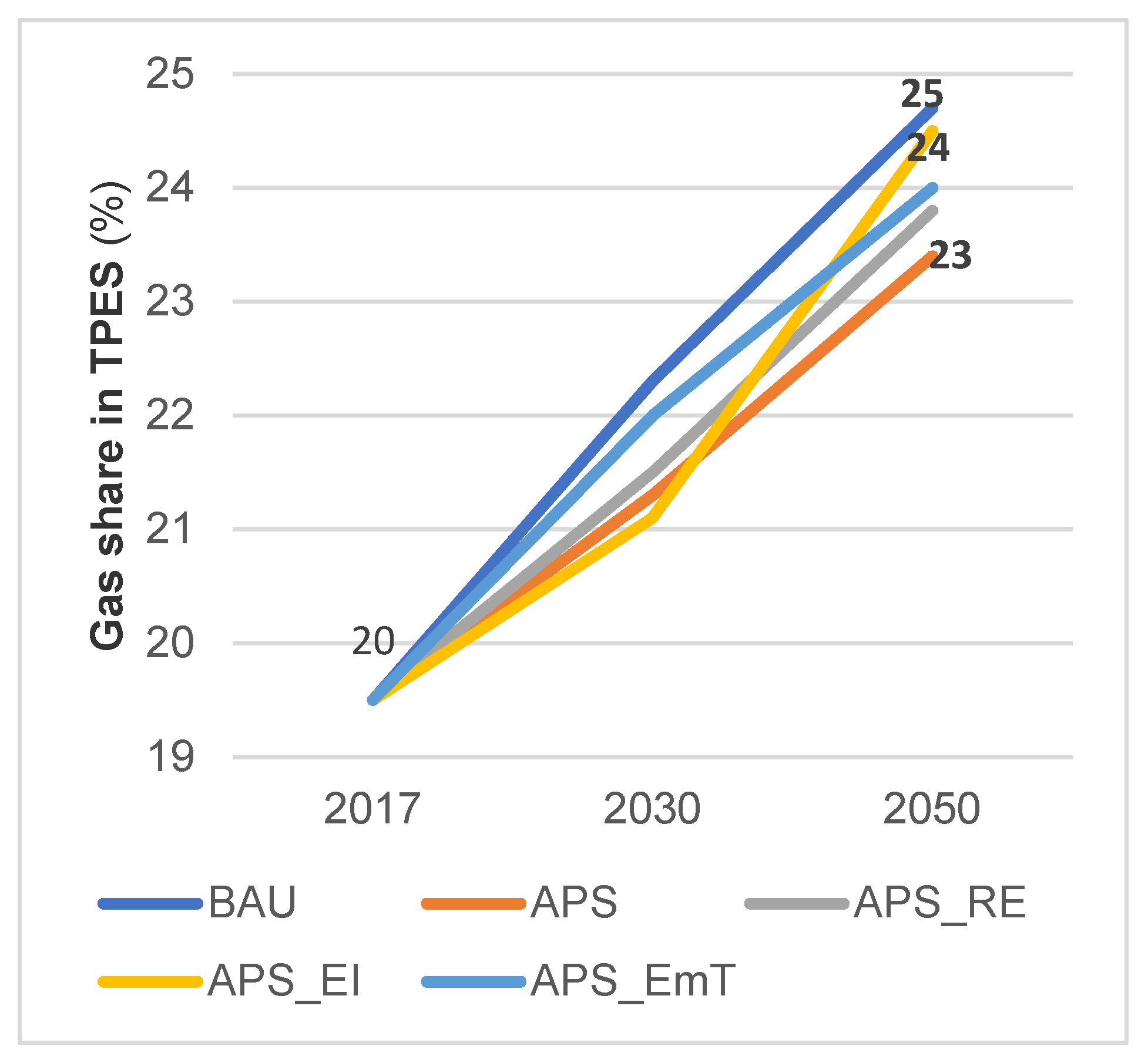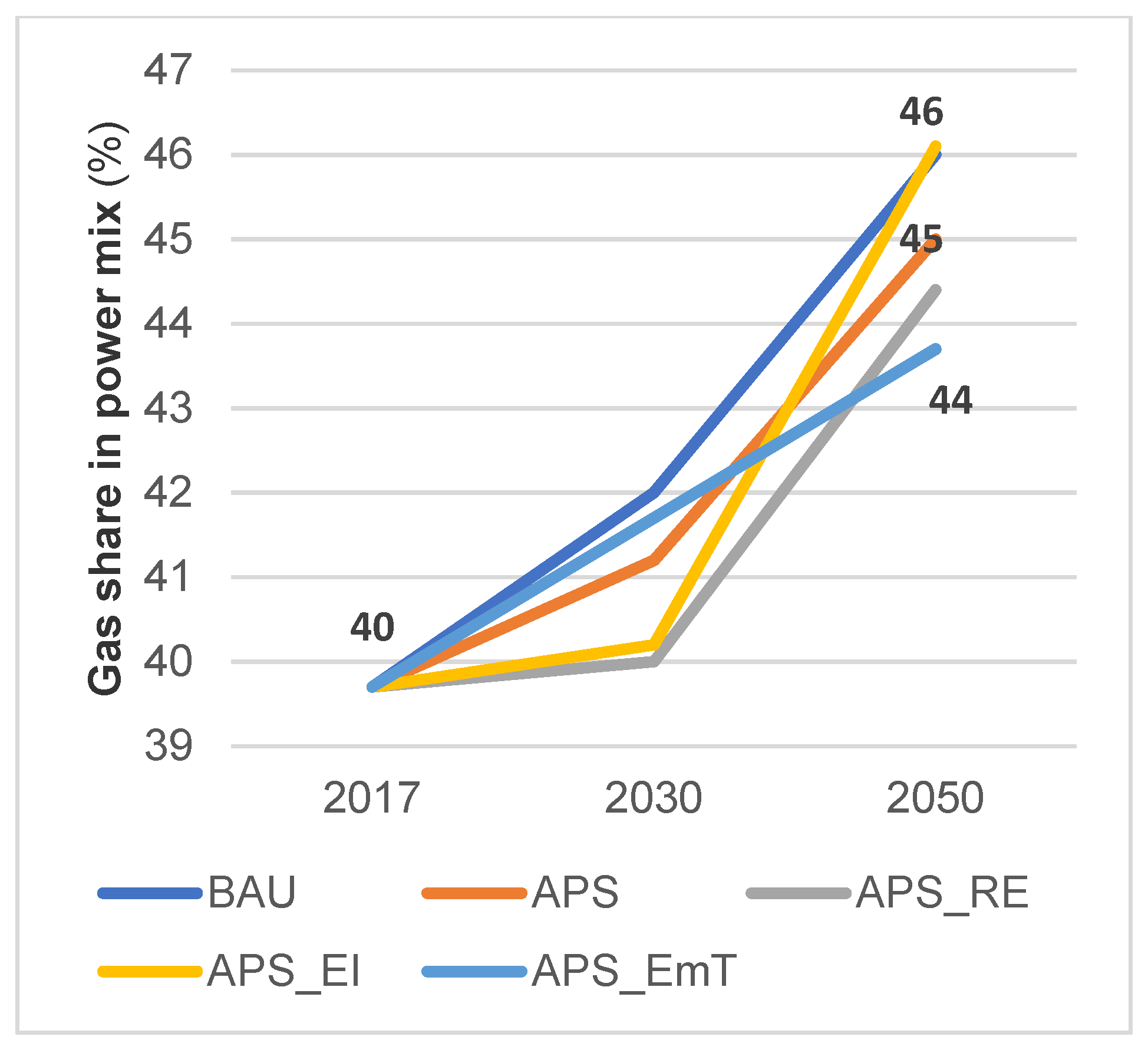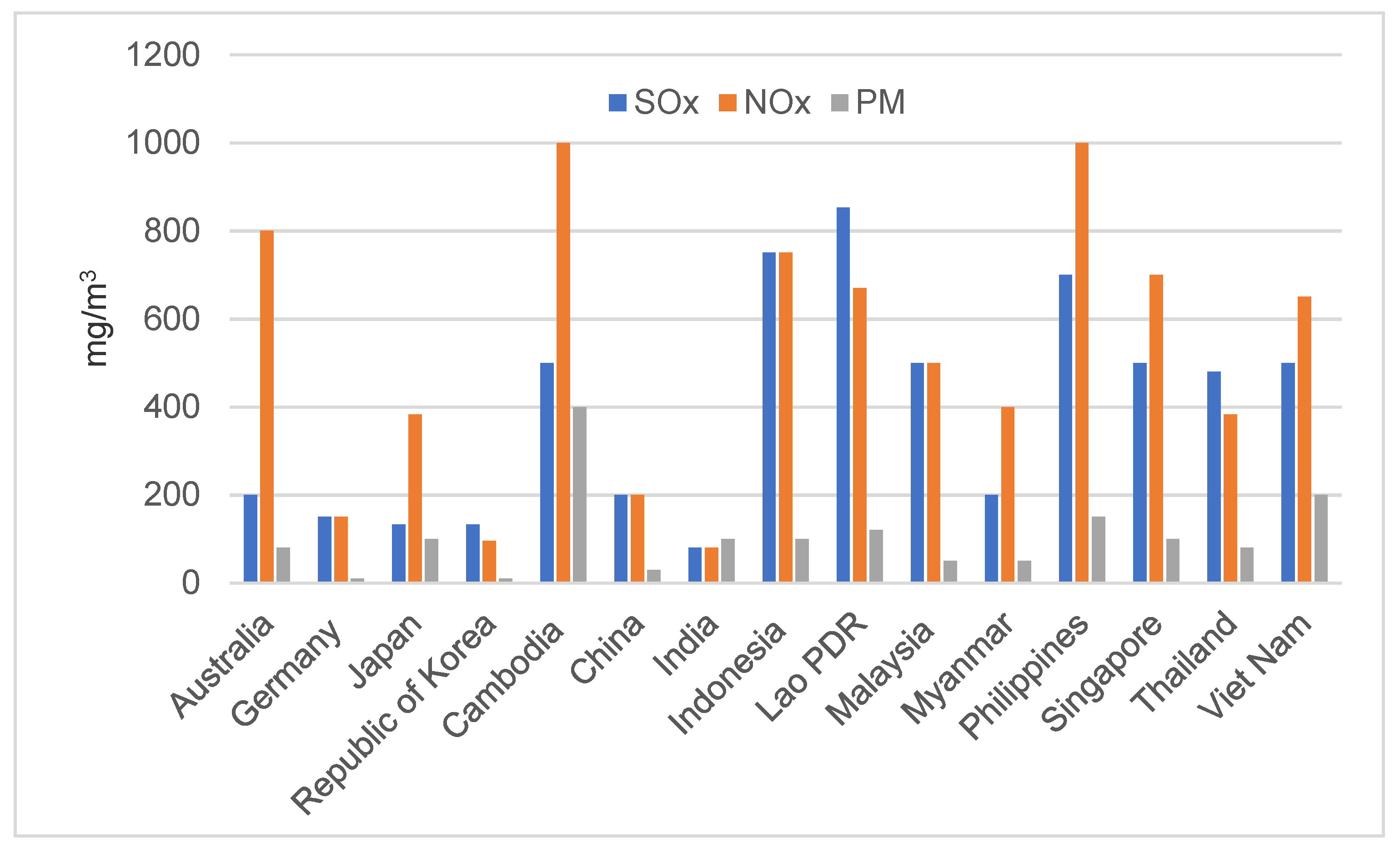Figure 1.
Average Annual Growth Rate of GDP (%) and Population in AMS, 2017–2050. AMS = ASEAN Member States, ASEAN = Association of Southeast Asian Nations, GDP-AAGR = average annual growth rate of GDP, POP-AAGR = average annual growth rate of the population. Source: Authors’ calculations.
Figure 1.
Average Annual Growth Rate of GDP (%) and Population in AMS, 2017–2050. AMS = ASEAN Member States, ASEAN = Association of Southeast Asian Nations, GDP-AAGR = average annual growth rate of GDP, POP-AAGR = average annual growth rate of the population. Source: Authors’ calculations.
Figure 2.
Primary Energy Supply (TPES) in ASEAN. APS = alternative policy scenario, APS_EI = alternative policy scenario with energy intensity targets, APS_EmT = alternative policy scenario with emission reduction targets, APS_RE = alternative policy scenario with renewable targets, ASEAN = Association of Southeast Asian Nations, BAU = business as usual, Mtoe = million tones of oil equivalent, TPES = total primary energy supply. Source: Authors’ calculations.
Figure 2.
Primary Energy Supply (TPES) in ASEAN. APS = alternative policy scenario, APS_EI = alternative policy scenario with energy intensity targets, APS_EmT = alternative policy scenario with emission reduction targets, APS_RE = alternative policy scenario with renewable targets, ASEAN = Association of Southeast Asian Nations, BAU = business as usual, Mtoe = million tones of oil equivalent, TPES = total primary energy supply. Source: Authors’ calculations.
Figure 3.
Energy Intensity in ASEAN. APS = alternative policy scenario, APS_EI = alternative policy scenario with energy intensity targets, APS_EmT = alternative policy scenario with emission reduction targets, APS_RE = alternative policy scenario with renewable targets, ASEAN = Association of Southeast Asian Nations, BAU = business as usual, GDP = gross domestic product. Source: Authors’ calculations.
Figure 3.
Energy Intensity in ASEAN. APS = alternative policy scenario, APS_EI = alternative policy scenario with energy intensity targets, APS_EmT = alternative policy scenario with emission reduction targets, APS_RE = alternative policy scenario with renewable targets, ASEAN = Association of Southeast Asian Nations, BAU = business as usual, GDP = gross domestic product. Source: Authors’ calculations.
Figure 4.
Share of Fossil Fuels (Coal, Oil, Gas) in the TPES. APS = alternative policy scenario, APS_EI = alternative policy scenario with energy intensity targets, APS_EmT = alternative policy scenario with emission reduction targets, APS_RE = alternative policy scenario with renewable targets, BAU = business as usual, TPES = total primary energy supply. Source: Authors’ calculations.
Figure 4.
Share of Fossil Fuels (Coal, Oil, Gas) in the TPES. APS = alternative policy scenario, APS_EI = alternative policy scenario with energy intensity targets, APS_EmT = alternative policy scenario with emission reduction targets, APS_RE = alternative policy scenario with renewable targets, BAU = business as usual, TPES = total primary energy supply. Source: Authors’ calculations.
Figure 5.
Share of Fossil Fuels in the Power Mix. APS = alternative policy scenario, APS_EI = alternative policy scenario with energy intensity targets, APS_EmT = alternative policy scenario with emission reduction targets, APS_RE = alternative policy scenario with renewable targets, BAU = business as usual. Source: Authors’ calculations.
Figure 5.
Share of Fossil Fuels in the Power Mix. APS = alternative policy scenario, APS_EI = alternative policy scenario with energy intensity targets, APS_EmT = alternative policy scenario with emission reduction targets, APS_RE = alternative policy scenario with renewable targets, BAU = business as usual. Source: Authors’ calculations.
Figure 6.
Oil Share in TPES in ASEAN. APS = alternative policy scenario, APS_EI = alternative policy scenario with energy intensity targets, APS_EmT = alternative policy scenario with emission reduction targets, APS_RE = alternative policy scenario with renewable targets, ASEAN = Association of Southeast Asian Nations, BAU = business as usual, TPES = total primary energy supply. Source: Authors’ calculations.
Figure 6.
Oil Share in TPES in ASEAN. APS = alternative policy scenario, APS_EI = alternative policy scenario with energy intensity targets, APS_EmT = alternative policy scenario with emission reduction targets, APS_RE = alternative policy scenario with renewable targets, ASEAN = Association of Southeast Asian Nations, BAU = business as usual, TPES = total primary energy supply. Source: Authors’ calculations.
Figure 7.
Oil Share in Final Demand in ASEAN. APS = alternative policy scenario, APS_EI = alternative policy scenario with energy intensity targets, APS_EmT = alternative policy scenario with emission reduction targets, APS_RE = alternative policy scenario with renewable targets, ASEAN = Association of Southeast Asian Nations, BAU = business as usual. Source: Authors’ calculations.
Figure 7.
Oil Share in Final Demand in ASEAN. APS = alternative policy scenario, APS_EI = alternative policy scenario with energy intensity targets, APS_EmT = alternative policy scenario with emission reduction targets, APS_RE = alternative policy scenario with renewable targets, ASEAN = Association of Southeast Asian Nations, BAU = business as usual. Source: Authors’ calculations.
Figure 8.
Coal Share in TPES in ASEAN. APS = alternative policy scenario, APS_EI = alternative policy scenario with energy intensity targets, APS_EmT = alternative policy scenario with emission reduction targets, APS_RE = alternative policy scenario with renewable targets, ASEAN = Association of Southeast Asian Nations, BAU = business as usual, TPES = total primary energy supply. Source: Authors’ calculations.
Figure 8.
Coal Share in TPES in ASEAN. APS = alternative policy scenario, APS_EI = alternative policy scenario with energy intensity targets, APS_EmT = alternative policy scenario with emission reduction targets, APS_RE = alternative policy scenario with renewable targets, ASEAN = Association of Southeast Asian Nations, BAU = business as usual, TPES = total primary energy supply. Source: Authors’ calculations.
Figure 9.
Coal Share in Generation Mix in ASEAN. APS = alternative policy scenario, APS_EI = alternative policy scenario with energy intensity targets, APS_EmT = alternative policy scenario with emission reduction targets, APS_RE = alternative policy scenario with renewable targets, ASEAN = Association of Southeast Asian Nations, BAU = business as usual. Source: Authors’ calculations.
Figure 9.
Coal Share in Generation Mix in ASEAN. APS = alternative policy scenario, APS_EI = alternative policy scenario with energy intensity targets, APS_EmT = alternative policy scenario with emission reduction targets, APS_RE = alternative policy scenario with renewable targets, ASEAN = Association of Southeast Asian Nations, BAU = business as usual. Source: Authors’ calculations.
Figure 10.
Gas Share in TPES in ASEAN. APS = alternative policy scenario, APS_EI = alternative policy scenario with energy intensity targets, APS_EmT = alternative policy scenario with emission reduction targets, APS_RE = alternative policy scenario with renewable targets, ASEAN = Association of Southeast Asian Nations, BAU = business as usual, TPES = total primary energy supply. Source: Authors’ calculations.
Figure 10.
Gas Share in TPES in ASEAN. APS = alternative policy scenario, APS_EI = alternative policy scenario with energy intensity targets, APS_EmT = alternative policy scenario with emission reduction targets, APS_RE = alternative policy scenario with renewable targets, ASEAN = Association of Southeast Asian Nations, BAU = business as usual, TPES = total primary energy supply. Source: Authors’ calculations.
Figure 11.
Gas Share in Generation Mix. APS = alternative policy scenario, APS_EI = alternative policy scenario with energy intensity targets, APS_EmT = alternative policy scenario with emission reduction targets, APS_RE = alternative policy scenario with renewable targets, ASEAN = Association of Southeast Asian Nations, BAU = business as usual. Source: Authors’ calculations.
Figure 11.
Gas Share in Generation Mix. APS = alternative policy scenario, APS_EI = alternative policy scenario with energy intensity targets, APS_EmT = alternative policy scenario with emission reduction targets, APS_RE = alternative policy scenario with renewable targets, ASEAN = Association of Southeast Asian Nations, BAU = business as usual. Source: Authors’ calculations.
Figure 12.
Renewables Share in Power Mix. APS = alternative policy scenario, APS_EI = alternative policy scenario with energy intensity targets, APS_EmT = alternative policy scenario with emission reduction targets, APS_RE = alternative policy scenario with renewable targets, ASEAN = Association of Southeast Asian Nations, BAU = business as usual. Source: Authors’ calculations.
Figure 12.
Renewables Share in Power Mix. APS = alternative policy scenario, APS_EI = alternative policy scenario with energy intensity targets, APS_EmT = alternative policy scenario with emission reduction targets, APS_RE = alternative policy scenario with renewable targets, ASEAN = Association of Southeast Asian Nations, BAU = business as usual. Source: Authors’ calculations.
Figure 13.
Share of Wind and Solar in Power Mix. APS = alternative policy scenario, APS_EI = alternative policy scenario with energy intensity targets, APS_EmT = alternative policy scenario with emission reduction targets, APS_RE = alternative policy scenario with renewable targets, ASEAN = Association of Southeast Asian Nations, BAU = business as usual. Source: Authors’ calculations.
Figure 13.
Share of Wind and Solar in Power Mix. APS = alternative policy scenario, APS_EI = alternative policy scenario with energy intensity targets, APS_EmT = alternative policy scenario with emission reduction targets, APS_RE = alternative policy scenario with renewable targets, ASEAN = Association of Southeast Asian Nations, BAU = business as usual. Source: Authors’ calculations.
Figure 14.
Emission Reduction in Various Scenarios. APS = alternative policy scenario, APS_EI = alternative policy scenario with energy intensity targets, APS_EmT = alternative policy scenario with emission reduction targets, APS_RE = alternative policy scenario with renewable targets, ASEAN = Association of Southeast Asian Nations, BAU = business as usual. Mt-C = million tonnes of carbon. Source: Authors’ calculations.
Figure 14.
Emission Reduction in Various Scenarios. APS = alternative policy scenario, APS_EI = alternative policy scenario with energy intensity targets, APS_EmT = alternative policy scenario with emission reduction targets, APS_RE = alternative policy scenario with renewable targets, ASEAN = Association of Southeast Asian Nations, BAU = business as usual. Mt-C = million tonnes of carbon. Source: Authors’ calculations.
Figure 15.
Emission Reduction in the Power Mix. APS = alternative policy scenario, APS_EI = alternative policy scenario with energy intensity targets, APS_EmT = alternative policy scenario with emission reduction targets, APS_RE = alternative policy scenario with renewable targets, ASEAN = Association of Southeast Asian Nations, BAU = business as usual. Source: Authors’ calculations.
Figure 15.
Emission Reduction in the Power Mix. APS = alternative policy scenario, APS_EI = alternative policy scenario with energy intensity targets, APS_EmT = alternative policy scenario with emission reduction targets, APS_RE = alternative policy scenario with renewable targets, ASEAN = Association of Southeast Asian Nations, BAU = business as usual. Source: Authors’ calculations.
Figure 16.
Required Investment for Variable Renewable Energy (Solar and Wind) by 2050. APS = alternative policy scenario, APS_EI = alternative policy scenario with energy intensity targets, APS_EmT = alternative policy scenario with emission reduction targets, APS_RE = alternative policy scenario with renewable targets, ASEAN = Association of Southeast Asian Nations, BAU = business as usual. Source: Authors’ calculations.
Figure 16.
Required Investment for Variable Renewable Energy (Solar and Wind) by 2050. APS = alternative policy scenario, APS_EI = alternative policy scenario with energy intensity targets, APS_EmT = alternative policy scenario with emission reduction targets, APS_RE = alternative policy scenario with renewable targets, ASEAN = Association of Southeast Asian Nations, BAU = business as usual. Source: Authors’ calculations.
Figure 17.
Emissions Standards for Newly Constructed Coal-Fired Power Plants in Selected Countries. Lao PDR = Lao People Democratic Republic, mg/m
3 = milligram per cubic metre, NOx—nitrogen oxides, PM = particulate matter, SOx—sulphur oxides. Source: Motokura et al. (2017) [
26].
Figure 17.
Emissions Standards for Newly Constructed Coal-Fired Power Plants in Selected Countries. Lao PDR = Lao People Democratic Republic, mg/m
3 = milligram per cubic metre, NOx—nitrogen oxides, PM = particulate matter, SOx—sulphur oxides. Source: Motokura et al. (2017) [
26].
Table 1.
Other Assumptions of Energy Saving Targets under the APS by AMS.
Table 1.
Other Assumptions of Energy Saving Targets under the APS by AMS.
| Country | Assumptions |
|---|
| Brunei Darussalam | Electricity: 35% reduction target by 2050 |
| Cambodia | Specific fuel efficiency target by 2050 included (coal, oil, gas, biomass industry, 10%; electricity efficiency target, 20%) |
| Indonesia | Sectoral target by 2050 (commercial and residential, 10%; transport, 20%; bioethanol blending increase to 15% from 3–7% in 2010) |
| Lao PDR | Biodiesel: 20% blend from 1–5% in 2010; utilization of biofuels equivalent to 10% of road transport fuels |
| Malaysia | 16% electricity saving by 2050 in industry, commercial, and residential sectors; 16% oil saving in final consumption by 2050; replacement of 5% of diesel in road transport with biodiesel |
| Myanmar | Target saving by 2050 included (transport and residential by 20%; industry, commercial, and others by 10%); replacement of 8% of transport diesel with biodiesel |
| Philippines | 20% saving of oil and electricity by 2050; displacement of 20% of diesel and gasoline with biofuels by 2025 |
| Thailand | Energy efficiency targets by 2050 included (transport, 70%; residential, 10%; commercial, 40%; and industry, 20% reduction of final energy demand); biofuels to displace 12.2% of transport energy demand |
| Viet Nam | 20% reduction for all sectors; 10% ethanol blend in gasoline for road transport |
